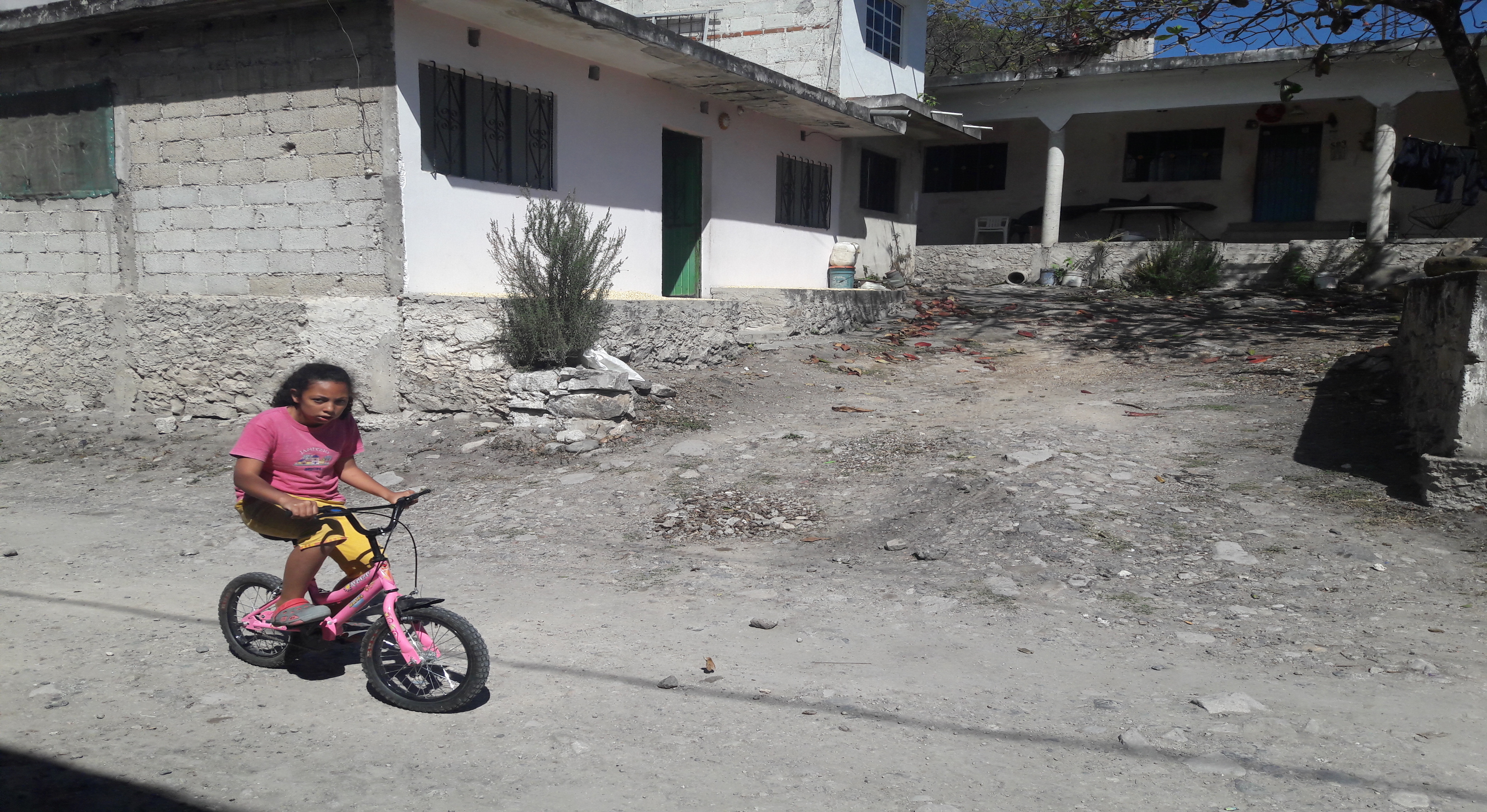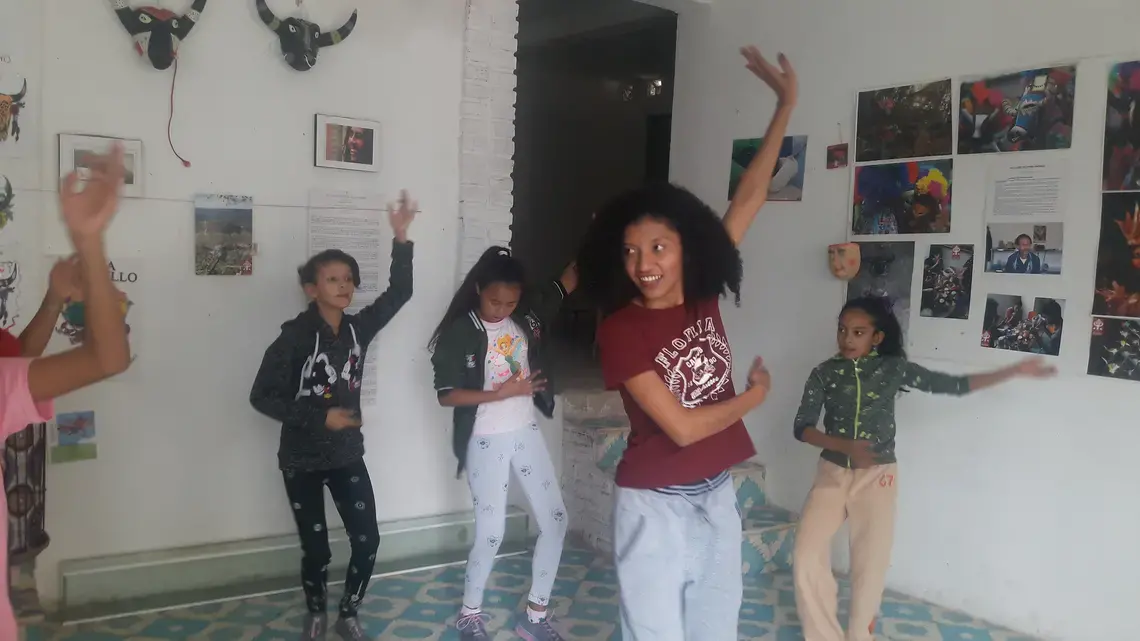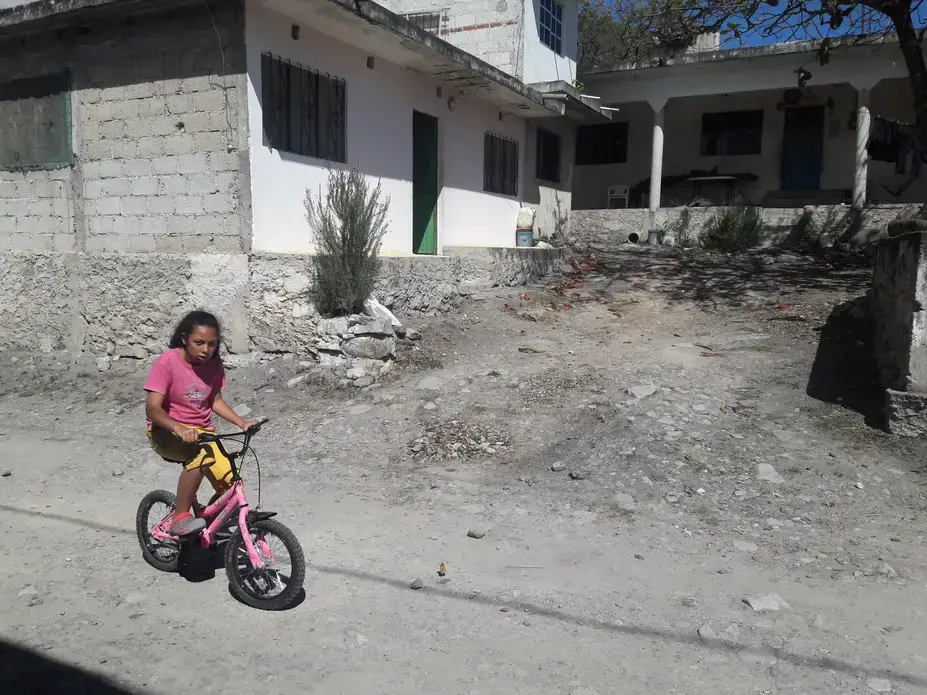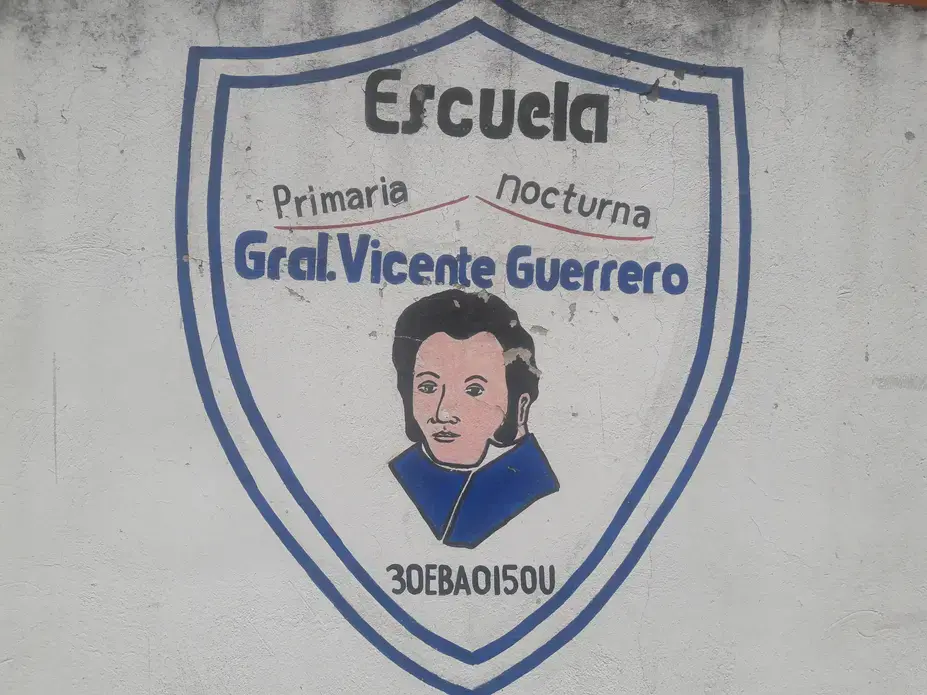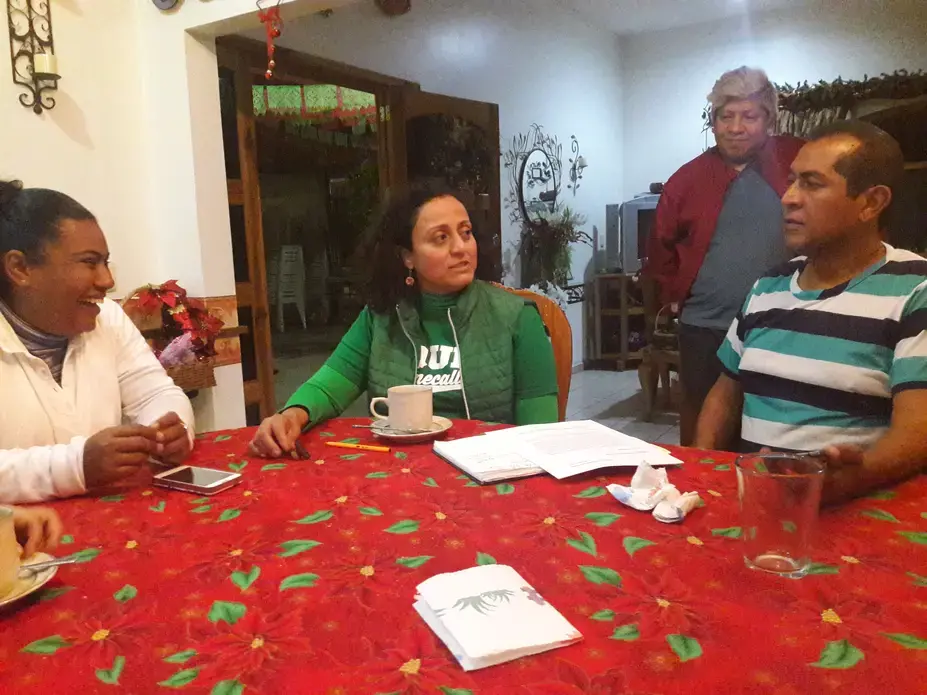Rocky, uneven, and unlined streets slope throughout town. Separate piles of stones and wood lay against one-story homes layered with red and gray bricks. A young, brown-skinned girl sporting a tied-up curly mane navigates her town's terrain on her bicycle. The adults in Coyolillo pedal as well, but through a fight for visibility and recognition.
Coyolillo is a small town made up of nearly 4,000 residents that serves as one of the few examples of black activism in the Mexican coastal state of Veracruz. Best known for its version of the annual Carnaval, a festival featuring traditional African dance and music, the town welcomes visitors with an affirmation of its identity: Afro-Mestizo. The term applies to one of mixed African descent.
Daniela Lopez Carreto began to strongly identify as Afro-Mexican while on a bus ride to her high school in a town about 30 minutes away from Coyolillo. She overheard a man speaking about the black history of her town and how it was founded. "From there, I started to pay more attention to all that is Carnaval, as the festival that's most tied to our origin."
Prior to overhearing the gentleman historian, Carreto had learned little of black history in her town, state, and country.
This isn't uncommon. State-mandated textbooks don't include the contributions of Afro-descendants.
HIDDEN HISTORY
Abel Villanueva Hernandez, an activist for México Negro, or Black Mexico, an organization that has been at the forefront of Afro-Mexican visiblisation since 1991, and an operational staff member for the National Human Rights Commission (CNDH) whose job entails working with the Afro-descendant population, only ever remembered seeing a photo of a black man playing the drums, while studying in the southern state of Oaxaca. "There is nothing in the textbooks," said the Cuajinicuilapa native, a predominantly Afro-Mexican city in the southern state of Guerrero.
Beginning in the 16th century, about 200,000 slaves were shipped to Mexico by Spanish conquistadors, mostly through the port of Veracruz. Between the 1500s and 1600s, an estimated one of every two slaves en route to the Caribbean was dropped off in Mexico. Many slaves escaped when they landed and sought refuge in the mountainous regions of the state. One revolutionary, only known as Yanga, led attacks against the Spanish army for over 30 years.
After three decades of warring with Yanga, the Spanish decided they had enough and agreed on peace terms with him. On August 10, 1609, San Lorenzo de Los Negros, later known as Yanga, was founded. It is considered to be the first liberated and independent town in the Americas, 11 years before the pilgrims landed at Plymouth Rock.
Mexico's second president Vicente Guerrero and Jose Maria Morelos, a political and military leader, were also Afro-Mexican and played crucial roles in achieving Mexico's independence from Spain during the Mexican Revolution in the early 19th century. Morelos wrote the doctrine Feelings of a Nation that called for the eradication of slavery, among other constitutional propositions. Guerrero eliminated enslavement in 1830 during his presidency, along with a racial caste system, which, ironically, could be one of the various reasons why there is so little acknowledgment of blacks in Mexico's history.
THE ACTIVISTS
Hugo Arellanes, a photographer who works with the activist organization Huella Negra, or Black Footprint, says, "We are affected by the fact that Vicente Guerrero is not recognized as an Afro-descendant. He keeps being painted as white in the pictures in where he is presented as the president of the republic, and the same goes for Jose Maria Morelos."
Starting in 2013, Huella Negra focused its efforts on increasing visibility for Afro-descendant populations and combating negative stereotypes that apply traits like aggressiveness, lack of intelligence, and poor work ethic to Afro-Mexican men, as well as, exotic and fiery traits to Afro-Mexican women. Along with Mexico Negro, Huella Negra, was one of many leading organizations at the forefront of the historic 2015 national census, which permitted Mexicans to officially claim Afro-descendancy for the first time. Approximately 1.4 million identified as such and the number more than doubled to 2.9 million in the 2017 National Survey on Discrimination led by the Governing Secretary and the National Council to Prevent Discrimination (CONAPRED).
México Negro was started in 1991 by Sergio Peñaloza Pérez, who is seen by many, including his protege Hernandez, as a living legend. A deceased legend would be Gonzalo Aguirre Beltrán, the first to research the Afro-Mexican population. The anthropolgist published The Black Population of Mexico, 1519-1810: Ethnohistoric Study in 1946, focusing on communities in Guerrero and paving the way for future researchers, one of whom, is Gabriela Iturralde Nieto.
Nieto, a social anthropologist and Program Collaborator of Afro-descendants and Cultural Diversity Research at the National Institute of Anthropology and History (INAH), has been studying Afro-Mexican identity and organizing for over two decades. She says black history is excluded in Mexico and when incorporated, only viewed through the context of slavery. "The participation of the Afro-descendant population is left out. It's known that it's there. Their history is known."
A LACK OF ACKNOWLEDGMENT
This lack of acknowledgment enables many Mexicans to remain unaware of their Afro-descendancy. In addition to Afro-Mexican, Afro-mestizo and Afro-descendant, multiple self-identifying terms are implicitly linked with Afro-identity, including "jarocho" and "mascogo," used in Veracruz and the Northen Mexican region respectively. Some people, such as in Cualjinicualpa, Guerrero, only call themselves Black.
Nieto says that the lack of unity around one identifying term, such as Black or African-American in the United States or Afro-Latino elsewhere in Latin America, has been problematic and that the term "Afro-Mexican" should be adopted in Mexico's upcoming 2020 census, though it is not what's most important. "What I think is fundamental, more than what term is used in the [census] question, is to do a sensitization campaign because people only identify if they know their history. If people don't know their history and don't have positive references, why are they going to accept a term?"
However, Nieto believes that people should identify as they please and their perspective is crucial to understand, "From an academic or research position, I think there's a need to be respectful and to see in what contexts people favor one over the other and why."
Efforts to increase Afro-Mexican visibility are hamstrung by nonexistent to minimal national and local media coverage. Activists and organizations like Huella Negra hold workshops, panels, discussion, work with universities, and are increasingly active on social media to promote awareness and support.
DANIELA LOPEZ CARRETO
Carreto is looking to jump deeper into the fray. Having already started a non-profit group called Casa Coyolillo with her family and childhood friends, the recent college graduate, who also teaches a dance class in preparation for Carnaval every year, is in the process of forming an anti-racist club with a specific focus on hair.
At 20 years old, she began studying at the Universidad Veracruzana, the largest university in Xalapa, the capital city of Veracruz. Her hair was a familiar topic on a campus that features a state-of-the-art soccer field and sits above a pool of water that flows into Los Lagos, Xalapa's tourist attraction of a lake. "Everyone was talking about my hair; they wanted to touch my hair. I have never liked it."
That never happened in Coyolillo, where most people have curly hair.
Carreto had recently decided to go natural and stop combing or altering her hair. During that year's Carnaval, she participated in a celebratory African dance performance, which traditionally feature Guinean genre called sinte. Each of the eight days of the festival she had combed her hair, except for the last, skipping the routine due to lack of time. After reviewing photos and videos of the festivities, she preferred the look of her natural hair. "From there, I let my hair out all the time," she says.
Her mane has brought a lot of attention, not always positive.
A group of boys once called her a witch while she was walking with her mother in Xalapa. "I didn't know if I should go back, if I should explain it to them, if I should yell at them to be quiet, or just keep walking. It's something that we're fighting all the time."
SPEAKING OUT
Raquel Peña Virgen has had to fight too.
At 10-years-old, Virgen, whose 84-year-old mother Sosima Virgen claims lineage to the revolutionary Yanga, she and her cousins were stopped by a truck in Mexico City, which is about a six hour drive from her hometown Mata Clara, another Afro-Mexican locale layered in passion and pride. A group of men she described as "rateros," or gangsters, instructed them to enter their vehicle. They assumed Virgen and her cousins were from Central America because they were "too black to be Mexican," she recalls.
Virgen is wearing a white sweater over a multi-colored striped turtleneck, sporting curly hair knotted in a ponytail and white pants pressed against a padded, wooden bench in a large, gated house in Cuitláhuac, a town that's 10 minutes driving from Mata Clara. Her eyes meet the ceiling, failing to restrain tears as she remembers the traumatic experience.
Terrified, she and her cousins ran, escaping to the shelter of a nearby home. After the girls said they were being chased, the woman who owned the home called the police. The gangsters did not locate their Central Americans.
"It's a defense mechanism to normalize racist behavior," notes Virgen, who afterwards struggled to cope with the event. "It was an experience that I wanted to forget completely."
Mata Clara is home to over 3,000 Veracruzanos. Its roads are rocky and crooked with minimal organizational lines, driving indicators or street signs. Most homes aren't taller than a basketball hoop. Roosters and stray dogs slowly meander through the streets. "Mata Clara is huge," says resident and tour guide Efrain Blanco Vera, who also notes the strong presence of religion in the town helps sustain bonds within the community, "We're all united, here." The town is home to three different churches.
As is in Coyolillo, most Mata Clarans are employed in the fields, cutting tomatoes, cultivating corn, cucumbers, tamales and much more produce.
According to recent data from the National Institute of Statistics and Geography (INEGI), 31 million tons of corn were grown nationally in 2017, along with nearly two million of chile, over 3 million of tomatoes, over one million of onions, and over 56 million of sugarcane.
Fernando Carreto, a 25-year-old Coyolillo native, has contributed to the large quantity of produce and has been doing so for quite some time. "I basically woke up working."
According to the 2017 National Survey on Discrimination led by the Governing Secretary and the National Council to Prevent Discrimination, 11 percent of the population said they have darker skin complexions. Only 2.9 million of the 100 million Mexicans identified as Afro-Mexican.
Approximately 76 percent of Afro-descendants, who are also classified as Afro-Mexicans, are in the socioeconomic brackets of "Low" or "Lower Middle Class," though they have an unemployment rate 3 percent lower than the national average.
The upcoming 2020 national Mexican census is fast approaching. Activists and researchers like Arellanes and Nieto call for supportive Afro-Mexican legislation. Nieto says they need "punctual policies that last," including official recognition in the nation's constitution.
The fight continues.


